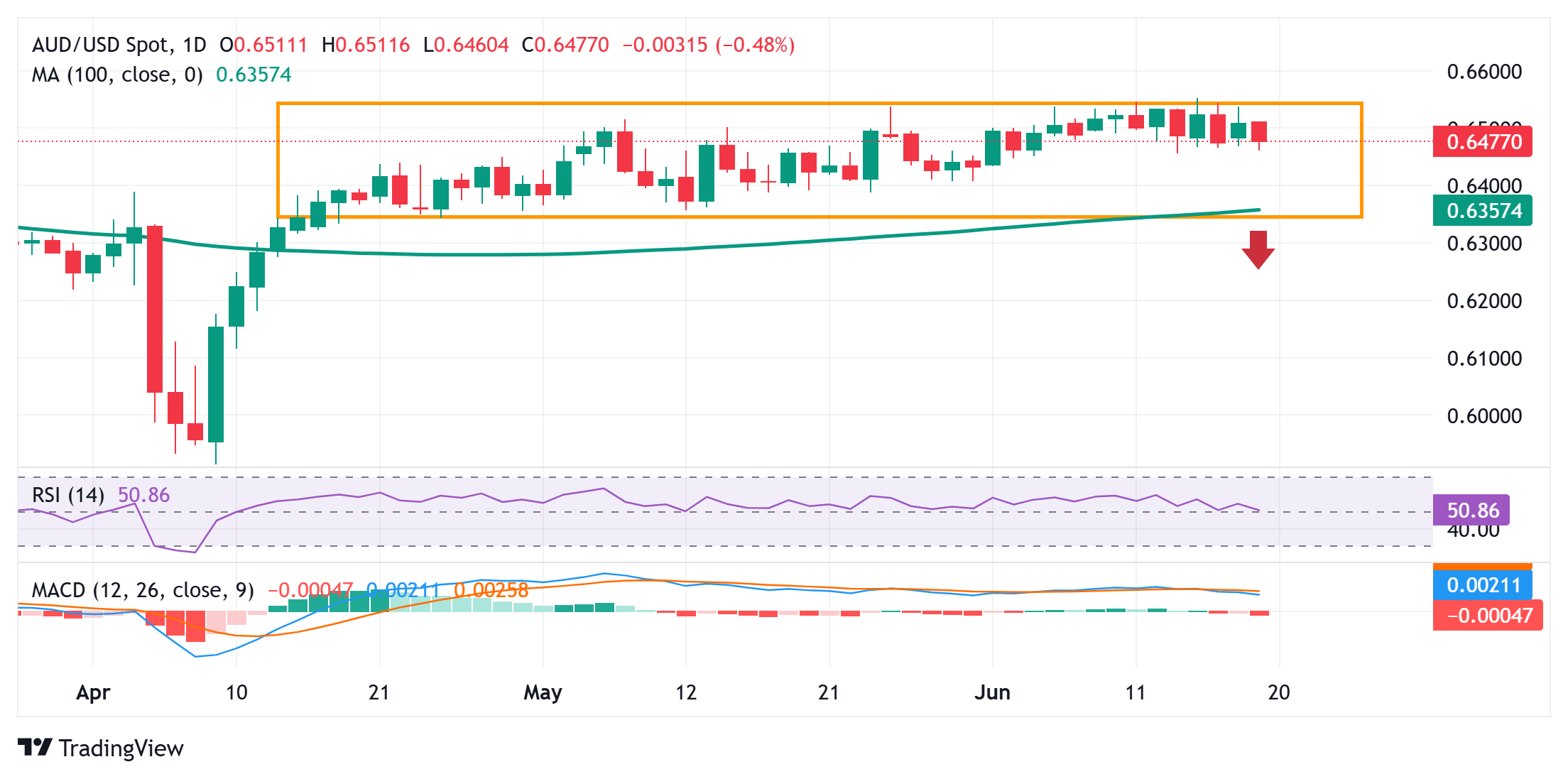
- AUD/USD drifts lower as disappointing Australian jobs report reaffirms July RBA rate cut bets.
- The Fed’s hawkish pause lifts the USD to over a one-week high and further weighs on the pair.
- Rising geopolitical tensions further benefit the USD and undermine the risk-sensitive Aussie.
The AUD/USD pair attracts fresh sellers following the disappointing release of Australian employment details and drops to a fresh weekly low during the first half of the European session on Thursday. The Australian Bureau of Statistics (ABS) reported that the number of employed people declined by 2.5K in May, missing consensus estimates for 25K by a big margin and well below the previous month’s downwardly revised reading of 87.6K. Meanwhile, unemployment remained steady at 4.1% due to the 0.1% fall in the labour force participation rate. Nevertheless, signs of weakness in the labour market back the case for the next interest rate cut by the Reserve Bank of Australia (RBA) in July and weighs heavily on the Australian Dollar (AUD).
The US Dollar (USD), on the other hand, draws support from the Federal Reserve’s (Fed) hawkish pause on Wednesday and the global flight to safety. In fact, the US central bank, as was widely expected, kept interest rates steady amid concern that the Trump administration’s tariffs could push up consumer prices. In the so-called dot plot, the committee projected two rate cuts by the end of 2025, though policymakers forecasted only one 25-basis points rate cut in each of 2026 and 2027. Moreover, seven of the 19 Fed officials indicated that they wanted no cuts this year, up from four in March, amid the risk that inflation could stay persistently higher and end the year at 3%. The outlook assists the USD to build on this week’s recovery from a three-year low.
Meanwhile, the global risk sentiment remains fragile on the back of concerns over rising geopolitical tensions in the Middle East. As the Israel-Iran conflict enters its seventh day, media reports suggest that Trump has approved attack plans for Iran but is holding off to see if Tehran will abandon its nuclear program. Moreover, the Israeli Air Force bombed Iran’s Arak heavy water reactor this morning, along with dozens of other military sites overnight. In response, Iran launched a fresh barrage of ballistic missiles at Israel. This, along with potential US involvement, raises the risk of an all-out war in the Middle East and continues to weigh on investors’ sentiment, benefiting the safe-haven Greenback and driving flows away from the risk-sensitive Aussie.
Apart from this, worries about Trump’s erratic trade policies keep investors on edge and support prospects for a further near-term depreciating move for the AUD/USD pair. In fact, Trump said earlier this week that tariffs on the pharma sector are coming soon. This adds a layer of uncertainty in the markets ahead of the July 9 deadline for sweeping “liberation day” tariffs and validates the negative outlook for the currency pair. However, it will still be prudent to wait for a sustained break below a multi-week-old trading range in order to confirm that spot prices have topped out. This, in turn, will set the stage for some meaningful corrective decline from a fresh year-to-date high, around mid-0.6500s touched on Monday.
AUD/USD daily chart

Technical Outlook
From a technical perspective, weakness below the 0.6450 region could find some support near the 0.6430 area. A convincing break below the latter could drag the AUD/USD pair to the next relevant support near the 0.6365-0.6360 confluence, comprising the lower boundary of the short-term range and the 100-day Simple Moving Average (SMA). Some follow-through selling will be seen as a fresh trigger for bearish traders, making spot prices vulnerable to slide further towards the 0.6300 round figure en route to the 0.6245 support and sub-0.6200 levels.
On the flip side, any meaningful recovery back above the 0.6500 psychological mark might continue to attract some sellers near the 0.6545-0.6550 region. The said area represents the year-to-date peak and the top end of the short-term trading range, which if cleared decisively will be seen as a fresh trigger for bullish traders. The AUD/USD pair might then aim to reclaim the 0.6600 mark and climb further towards the 0.6640 hurdle, and the 0.6680 region, or November 2024 swing high.
Information on these pages contains forward-looking statements that involve risks and uncertainties. Markets and instruments profiled on this page are for informational purposes only and should not in any way come across as a recommendation to buy or sell in these assets. You should do your own thorough research before making any investment decisions. FXStreet does not in any way guarantee that this information is free from mistakes, errors, or material misstatements. It also does not guarantee that this information is of a timely nature. Investing in Open Markets involves a great deal of risk, including the loss of all or a portion of your investment, as well as emotional distress. All risks, losses and costs associated with investing, including total loss of principal, are your responsibility. The views and opinions expressed in this article are those of the authors and do not necessarily reflect the official policy or position of FXStreet nor its advertisers. The author will not be held responsible for information that is found at the end of links posted on this page.
If not otherwise explicitly mentioned in the body of the article, at the time of writing, the author has no position in any stock mentioned in this article and no business relationship with any company mentioned. The author has not received compensation for writing this article, other than from FXStreet.
FXStreet and the author do not provide personalized recommendations. The author makes no representations as to the accuracy, completeness, or suitability of this information. FXStreet and the author will not be liable for any errors, omissions or any losses, injuries or damages arising from this information and its display or use. Errors and omissions excepted.
The author and FXStreet are not registered investment advisors and nothing in this article is intended to be investment advice.








